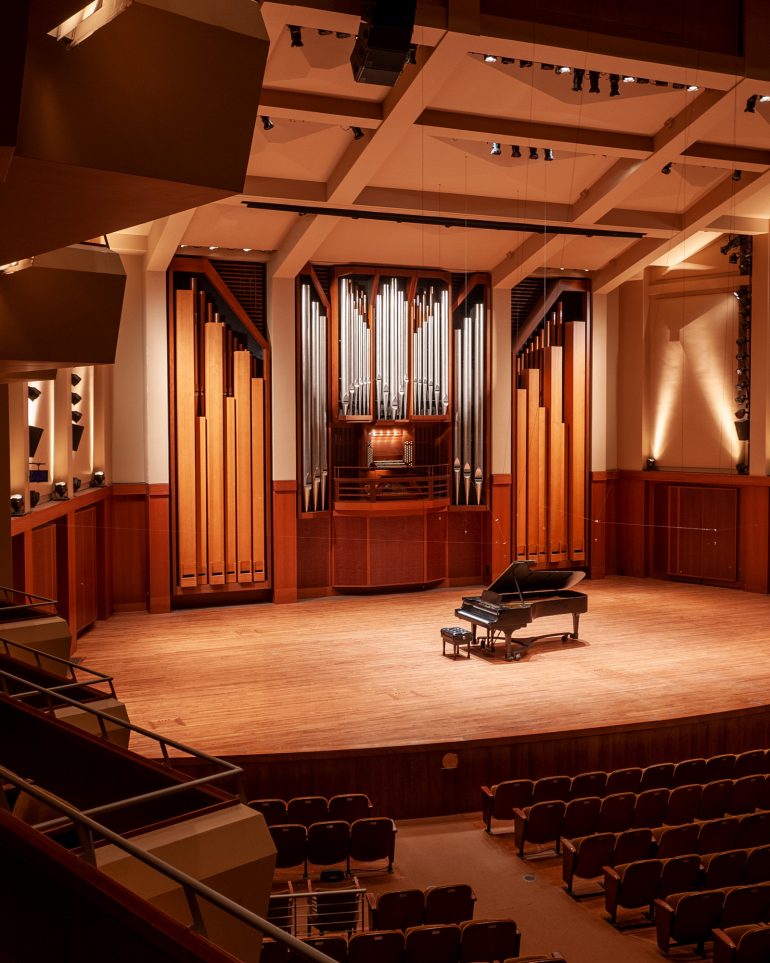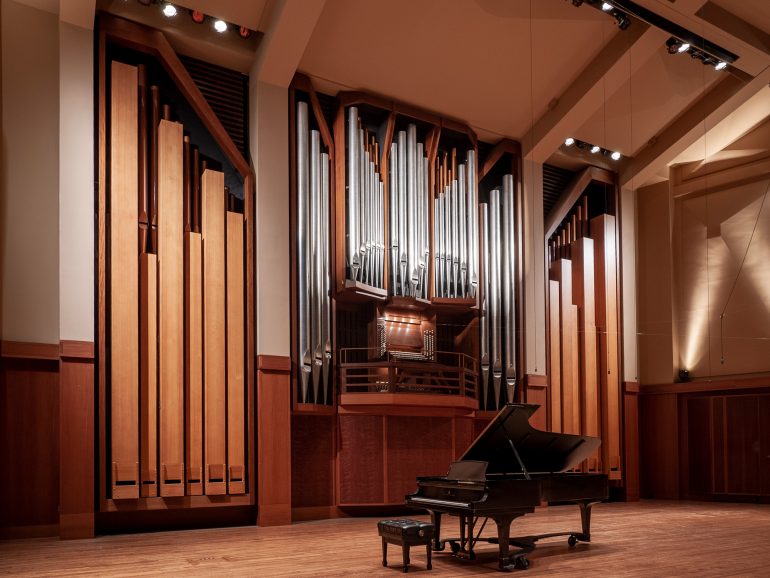
- phone: 978.283.1909
- email: cbfisk@cbfisk.com
Opus 114
Benaroya Hall
Seattle, WA
Ranks: 83Independent Voices: 62
Pipes: 4490
Created: 2000
Opus 114 was the gift of Craig and Joan Watjen, long-time supporters of the Seattle Symphony. From the earliest days of planning for Benaroya Hall, an organ had been included in the overall design. Upon viewing initial architectural conceptions of the new hall and pipe organ, Craig Watjen recognized the instrument as an important symbol for the orchestra’s new home. Mr. Watjen, a professional clarinetist and software executive with degrees in music from the Juilliard School and the New England Conservatory, identified the organ as the best way to support the symphony in its new hall.
In designing Opus 114, our task was to create a powerful and flexible instrument with the resources to play music from many periods and genres. The Great and the Positive have French and German reeds while the Swell is entirely French Romantic. The Solo division, powerful enough to hold its own with the entire symphony orchestra, features the Flauto Mirabilis and Clarinet as unique and engaging color stops; the bold Stentor Diapason 8′, Stentor Octave 4′, and Stentor Mixture are the principal chorus for use with orchestra. All these stops act as intermediaries to the spectacular tubas, the climax stops of the instrument.
The organ’s eighty-three ranks are arrayed in five divisions over three manuals and pedal. Natural keys are of cow bone with sharps of ebony; stop knobs are of cocobolo. The organ’s electric stop action includes the solid-state combination action with 128 levels of memory.
Three blowers totaling nearly twelve horsepower, and moving more than 3,100 cubic feet of air per minute, supply the wind required for this powerful instrument. The organ represents more than fifty thousand hours of work and weighs more than twenty-five tons.
Great, Manual I
Prestant 16′ façade
Octave 8′
Violoncelle 8′
Spillpfeife 8′
Flûte harmonique 8′
Octave 4′
Rohrflöte 4′
Quite 2 2/3′
Superoctave 2′
Terz 1 3/5′
Mixture VI-VIII
Bombarde 16′
Trommeten 8′
Trompette 8′
Clairon 4′
Tuba Magna 16′ ext
Tuba Mirabilis 8′
Tuba Clarion 4′
Positive, Manual II
Quintaton 16′
Principal 8′
Salicional 8′
Unda maris 8′
Gedackt 8′
Octave 4′
Baarpijp 4′
Grosse Tierce 3 1/5′
Nasard 2 2/3′
Doublette 2′
Quarte de Nasard 2′
Tierce 1 3/5′
Larigot 1 1/3′
Piccolo 1′
Sharp IV-VI
Dulcian 16′
Trompette 8′
Cromorne 8′
Tuba Magna 16′
Tuba Mirabilis 8′
Tuba Clarion 4′
Swell, Manual III
enclosed
Bourdon 16′
Diapason 8′
Viole de gambe 8′
Voix céleste 8′
Flûte traversière 8′
Bourdon 8′
Prestant 4′
Flûte octaviante 4′
Octavin 2′
Cornet II (c1-g3)
Plein jeu III-IV
Bombarde 16′
Trompette 8′
Hautbois 8′
Voix humaine 8′
Clairon 4′
Solo, 61 notes
This division is played from the
Great, Tuba Mirabilis is
enclosed with Solo
Stentor Diapason 8′
Flauto Mirabilis 8′ c1
Stentor Octave 4′
Stentor Mixture III-IV
Clarinet 8’
Pedal, 32 notes
Prestant 32′ (en façade from FF)
Untersatz 32′
Open Wood 16′ 32′
Montre 16′ (in façade)
Prestant 16′ Great
Violonbasse 16′
Bourdon 16′ Swell
Gross Quinte 10 2/3′
Octave 8′
Open Flute 8′ 32′
Violoncelle 8′ Great
Spillpfeife 8′ Great
Superoctave 4′
Mixture IV
Tuba Profunda 32′ ext
Tuba Magna 16′ Great
Bombarde 16′ Great
Posaune 16′
Tuba Mirabilis 8′ Great
Trommeten 8′ Great
Trompette 8′ Great
Tuba Clarion 4′ Great
Clairon 4′ Great
Couplers:
Positive to Great
Swell to Great
Swell to Positive
Machine on Great
Octaves graves
Great to Pedal
Positive to Pedal
Swell to Pedal
Swell Super to Pedal
Accessories:
General Tremulant
Swell Tremolo rapidé
Solo Tremulant
Flexible Wind
Key action: Direct mechanical (tracker)
Kowalyshyn Servo-pneumatic Lever
Stop action: Electric Solenoid
Combination Action
Front Pipes of Sitka Spruce & Spotted Metal


